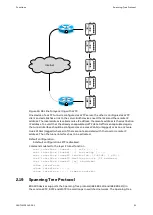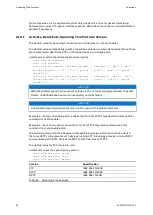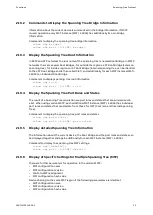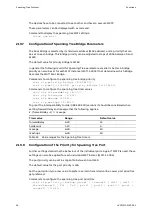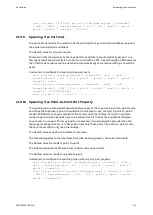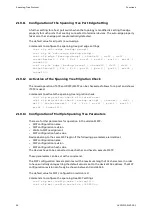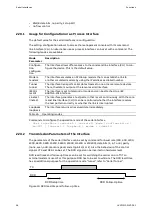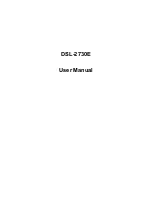
Functions
DSL Interfaces
Commands to configure the connection cut of DSL interfaces
< s e t i n t e r f a c e { d s l 1 | d s l 2 } b a d l i n e - d i s c o n n e c t { f a s t |
2.15.5
Configuration of Data Encapsulation
The legacy EDS500 devices and 3rd party equipment may use another kind of data
encapsulation for the DSL transmission than current devices. Still, two devices of different
generations or vendors can be connected via a common mode. In case of legacy EDS500, this
device should be configured to the interface mode slave and the counterpart correspondingly
to the mode master (refer to Chapter 2.15.2, "Configuration of the Mode (Master, Slave)").
Device types, connected to each other
DSL data encapsulation on both sides
Current devices
hdlc-enhanced
Current device with EDS500 legacy
hdlc-compatible
EDS500 legacy with EDS500 legacy
hdlc-native
Current devices with third party
efm
Table 19:
Data encapsulation to connect with legacy EDS500 devices
ADVICE
The DSL interfaces of any two devices have to be connected with the same data
encapsulation.
Commands to configure the data enscapsulation of DSL interfaces
< s e t i n t e r f a c e { d s l 1 | d s l 2 } e n c a p s u l a t i o n { e f m | h d l c -
c o m p a t i b l e | h d l c - e n h a n c e d | h d l c - n a t i v e } >
2.15.6
Signal Quality, Line Length and Data Rate
2.15.6.1
Signal Quality
The signal quality describes the quality of a connection on the receive side as relative signal-
noise-ratio in dB, that is based on an absolute signal-noise-ratio of 30 dB at which a bit error
probability of 10-7 occurs.
The achievable signal quality depends on the impedance of the line (resistance, capacity and
inductivy) and the interference through other signals. For this the cable type (attenuation,
shield), the connections (impedance discondinity) and naturally the length of the line play a
role. On each side of the connection a value for the DSL signal quality is determined in the
device; these values are not necessarily identical on both sides (refer to Chapter 2.15.7, "Link
Analysis").
To have a buffer against fluctuations in quality (e.g. caused by interferences or cable faults)
it is sensible to aim for a minimum value for signal quality. Depending on the application
area (especially in respect to occurring interferences) values of 3 dB, 6 dB or more can
be necessary. But also an operation with a signal quality of 0 dB (bit error rate of 10-7) is
possible.
ADVICE
A pre-alarm and an alarm exist to monitor the signal quality of a DSL interface when a
threshold is reached.
1KGT151021
V000 1
43























